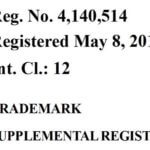What Is the Trademark Supplemental Register?
If you are reading this, you likely have an office action rejecting your trademark under Section 2(e) of the Trademark Act for being merely descriptive or geographically descriptive. Or, you have a distinctiveness rejection for a shape, color, or trade dress mark. One possible way around the rejection is to amend the trademark application to seek registration on the Supplemental Register. Often, the trademark Examining Attorney will advise of the amendment. Or, your trademark attorney suggested amending to the Supplemental Register. Whatever the case, the Supplemental Register questions are inevitable. Continue reading for a full explanation.

Supplemental Register Is for Marks that Cannot Function as Brand Identifiers.
There are two registers at the United States Trademark Office: The Principal Register and the Supplemental register. The Supplemental Register is a secondary register, which allows for the registration of marks that the Trademark Office finds are not capable of functioning as trademarks (standing alone), but may achieve trademark status upon a showing of evidence of public recognition and exclusive use for a period of time. In trademark legalese, the Secondary Register is for marks that are not inherently distinctive, and have not achieved secondary meaning.
JERSEY blue crabs, MAINE lobster, FLORIDA oranges, CALIFORNIA raisins, NAPA VALLEY wines, JAMAICAN Rum, CUBAN Cigars. The names identify a location of origin, not a brand (business of origin). These names inherently point to a geographic origin, and not a manufacturer of origin. These examples inherently fail to identify a brand (business of origin), but rather identify a location of origin. The Trademark Act rarely grants monopolies for geographic terms. The exception is when the name acquires secondary meaning. That is, when the public readily associates the name with a brand, rather than the location. For more information on this, visit my article PHILADELPHIA Cream Cheese – Geographically Descriptive Trademark Registrable With Secondary Meaning.
Supplemental Register vs. Principal Register – What are the differences?
Quick Summary:
Principal Register Trademarks Are Given a Presumption of Validity by Courts – Supplemental Register Trademarks Are Not
Both Trademark Registers Show Up in Trademark Searches and and Block Later-Filed Applications
Registered Trademarks Grant the Right to use the (R) Symbol, which puts on Notice of Trademark rights.
Registered Trademarks May Stop the Importation into the United States of Articles Bearing an Infringing Mark
Principal Trademark Registration Qualifies Sellers to Enroll in the Amazon Brand Registry
A Principal Register Trademark May Obtain Incontestable Status, which is Conclusive Evidence in Court of the Registrant’s Exclusive Right to use of the Mark
A Registered Trademark Gives Owners Credibility with Internet Service Providers (YouTube, eBay, Amazon, Facebook, Twitter, Pinterest and other social media and e-commerce websites) and often expedites e-commerce and Social Media Takedowns of Imposters and others Infringing your Trademark.
Registered Trademarks Provide a Basis for Foreign Trademark Applications and Registrations
Principal Register Trademarks Are Given a Presumption of Validity by Courts – Supplemental Register Trademarks Are Not
In court, the Principal Register Trademark Registration entitles a plaintiff to a presumption that the trademark is valid. With a Supplemental Register Trademark, a plaintiff must plead and prove the underlying facts that would establish that the trademark is enforceable. That is, a Supplemental Register trademark owner would have to show (1) that it adopted and used the mark in commerce, and (2) that the mark is recognized by the public as identifying plaintiff’s business. As such, more work is required in pleading and proving an infringement case for the Supplemental Register Owner. That being said, most Principal Register plaintiffs plead and establish the “underlying facts” anyway as part of a common law infringement or unfair competition claim. This is usually done as a safeguard in the instance the registration is attacked by the defendant or invalidated on other grounds. As such, I see this “Presumption of Validity for Principal but not Supplemental Registrants” issue as a minor distinction. As a plaintiff, if you have a true infringer profiting from your goodwill, you will succeed in obtaining redress from the courts.
Both Trademark Registers Show Up in Trademark Searches and and Block Later-Filed Applications
Like trademarks on the Principal Register, Supplemental trademarks come up in search results. Marks on the Supplemental Register also block later-filed applications. This allows a trademark owner to protect its mark while building its brand. As a matter of strategy, the Supplemental Register Trademark is an important tool for blocking new trademark applications. The owner of a supplemental register trademark can use this “blocking” time to gain enough exclusive use and /or public recognition to acquire secondary meaning (distinctiveness) for the mark. Once sufficient time of use and brand recognition is achieved, the owner can then file for a Principal Register trademark. For example, after 5 years of exclusive use, a mark is deemed to have acquired distinctiveness, which can then support a trademark on the Principal Register under Section 2(f) of the Trademark Act. Even before 5 years of use, if evidence supports exclusive use and widespread brand recognition, the owner can apply to the Principal Register under Section 2(f).
® – R Circle Symbol Is Available for Both Principal Register and Supplemental Register Trademark Registrations
Like Principal Trademark Owners, owners of Trademarks on the Supplemental Register can use the ® symbol. The r circle trademark symbol helps to put others on notice that the mark is registered with the U.S. Patent and Trademark Office.
A Supplemental Register Trademark Application Is Not Published For Opposition.
With Principal Register Trademarks, the application is published for 30 days to allow third-parties to oppose the pending application. No such trademark opposition proceeding is available to challenge a Supplemental Register trademark application. An applicant may use this loophole to its advantage to obtain a trademark registration absent the usual publication and opposition period.
A Supplemental Trademark Registration Must Be Renewed and Maintained
With one exception, maintenance and renewal of Supplemental Trademark Registrations are the same as trademarks on the Principal Register. Section 15 declarations are not required for Supplemental Trademarks, because trademarks on the supplemental register cannot gain incontestable status. This saves an applicant time and fees relating to one less trademark renewal filing. A Section 8 declaration is required between the 5th and 6th year from registration. Renewal applications are required on the decades succeeding registration.
Supplemental Registrations Are Used to Register International and Foreign Trademarks
Principal and Supplemental Registrations form the basis for international trademark filings under the Madrid Protocol. Like trademarks on the Principal Register, the filing date for the application can be used as a priority date for foreign filings. TMEP 1902
Supplemental Register Is Not Available for Intent-To-Use Trademark Applications
An intent-to-use applicant cannot overcome a rejection by amending to the Supplemental Register. In order to amend the application to the supplemental register, the applicant must first make an allegation of use. If the application was filed as an intent-to-use (Section 1(B)), the applicant must begin using the mark and convert the application to Section 1(A) by filing an allegation of use. Typically amending to the Supplemental Register becomes an option when facing an Office Action. The response time for an Office Action is 6 months. This creates an urgency to the applicant who must begin using the mark in commerce within the 6-month response period. Otherwise, the application may go abandoned.
A Separate Trademark Application Must Be Filed to Move the Trademark to the Principal Register
Amendment of a Supplemental trademark to the Principal Register is not permitted. Rather, a separate application is filed. Preferably, the new application is filed after five years of exclusive use of the mark. Five years of exclusive use provides basis to show that the mark has secondary meaning (acquired distinctiveness). A principal Section 2(f) claim can be made. As a matter of strategy, this is done while the Supplemental Register trademark is active. In the instance the new application is denied, the applicant still has the Supplemental trademark registration to block others from filing for the mark.
Trademark Supplemental Register — Frequently Asked Questions
What is the Trademark Supplemental Register? ›
Who should consider the Supplemental Register? ›
Does a Supplemental Registration block later-filed trademark applications? ›
Can I use the ® symbol with a Supplemental Registration? ›
Is a Supplemental application published for opposition? ›
Do Supplemental Registrations have a presumption of validity in court? ›
Can a Supplemental Registration become incontestable? ›
How do I move from the Supplemental to the Principal Register? ›
Principal vs. Supplemental Register — Comparison
| Feature | Principal Register | Supplemental Register |
|---|---|---|
| Inherent distinctiveness required | Yes (or 2(f) acquired distinctiveness) | No (intended for marks lacking inherent distinctiveness) |
| Publication for opposition | Yes (30-day opposition period) | No (not published for opposition) |
| Presumption of validity in court | Yes | No |
| Eligibility for incontestability (Section 15) | Yes (after meeting statutory criteria) | No |
| Use of ® symbol | Yes | Yes |
| Blocks later-filed confusingly similar applications | Yes | Yes |
| Amazon Brand Registry (policy-dependent) | Generally accepted | Generally not accepted |
| Madrid Protocol (international basis) | Yes | Yes |
| Intent-to-Use (1(b)) eligibility | Yes | Only after Allegation of Use (convert to 1(a)) |
| Path to Principal Register | N/A | File a new Principal application (often via 2(f)) after evidence of acquired distinctiveness |
Disclaimer: This information is for educational purposes, and is not intended to be legal advice. Each case turns on its own facts. Please consult with an experienced trademark attorney.
EsquireTrademarks.com – Online Trademark Attorneys – What We Do:
- Our trademark attorney, prepares and files trademark applications for clients throughout the United States and abroad.
- We prosecute and defend trademark infringement and unfair competition actions in the Federal Courts throughout the United States and abroad.
- We also prosecute trademark office actions and appeals before the United States Trademark Office.
- We handle internet based trademark disputes and trademark, DMCA, and copyright takedowns.
- We draw on our experience as trademark litigators to guide you through the trademark process.
- We support businesses, law firms, and individuals by providing top notch legal services in intellectual property matters.
